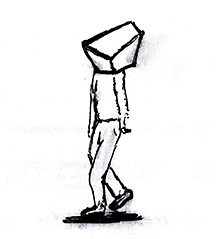 |
| Creating the carpets (picture courtesy aroundantigua.com) |
The trip coincided with Holy Week, and we got to see one of the country's richest traditions: the processions through town in Antigua. People use stencils to create elaborate carpets made out of colored sawdust and flower petals. Then groups of men bearing huge floats on which are sculptures of Jesus carrying the cross, Mary, and others walk through the carpets, the way Jesus entered Jerusalem, riding on a donkey, with palm branches and cloaks spread before him.
How about some elegantly patterned carpets of letters? We'll start with the block cryptics then. Hex in the National Post are already looking forward to April Fool's Day. Falcon wasn't tricked, of course. He has the solution at natpostcryptic.blogspot.com.
The New York Times has a cryptic byRichard Silvestri behind the paywall. Deb Amlen has comment (and spoilers) at Wordplay.
The Wall Street Journal has a new variety puzzle by Patrick Berry called "Pairing Up." You have to fit two letters into some of the spaces, but you're not told where. You'll need to start in one of the corners. Get one of the words right on the border, and use the intersecting words to figure where the double is. If you're still stuck, I have a hint grid and solution posted.
I also was thinking of Guatemala this year because two doctors from Guatemala City are here at Penn this academic year for studies in epidemiology and evidence-based practice. I get the privilege of teaching them the ins and outs of performing systematic reviews and assessing the strength and validity of research evidence.
(additional puzzles to follow)
Holy Week procession:

